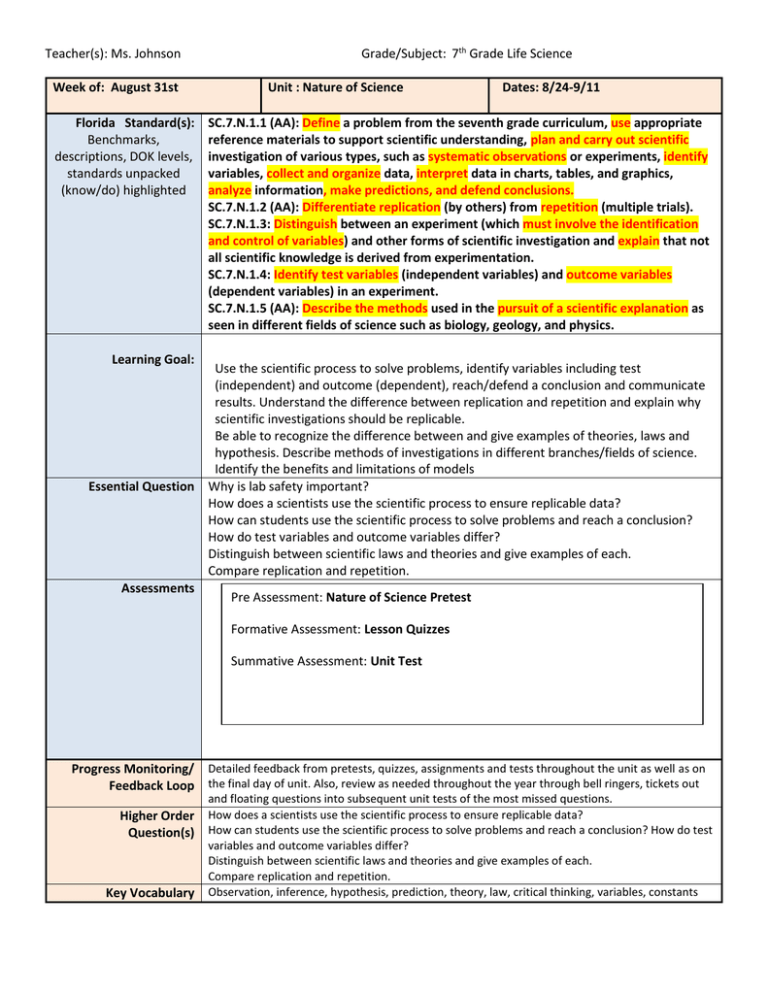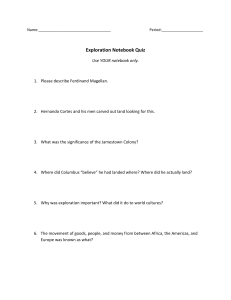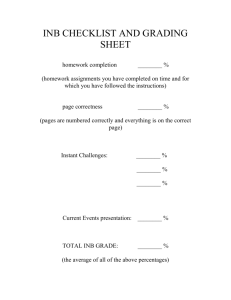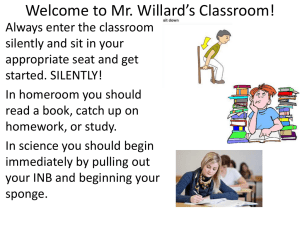Lesson Plans - August 31, 2015
advertisement

Teacher(s): Ms. Johnson Week of: August 31st Florida Standard(s): Benchmarks, descriptions, DOK levels, standards unpacked (know/do) highlighted Grade/Subject: 7th Grade Life Science Unit : Nature of Science Dates: 8/24-9/11 SC.7.N.1.1 (AA): Define a problem from the seventh grade curriculum, use appropriate reference materials to support scientific understanding, plan and carry out scientific investigation of various types, such as systematic observations or experiments, identify variables, collect and organize data, interpret data in charts, tables, and graphics, analyze information, make predictions, and defend conclusions. SC.7.N.1.2 (AA): Differentiate replication (by others) from repetition (multiple trials). SC.7.N.1.3: Distinguish between an experiment (which must involve the identification and control of variables) and other forms of scientific investigation and explain that not all scientific knowledge is derived from experimentation. SC.7.N.1.4: Identify test variables (independent variables) and outcome variables (dependent variables) in an experiment. SC.7.N.1.5 (AA): Describe the methods used in the pursuit of a scientific explanation as seen in different fields of science such as biology, geology, and physics. Learning Goal: Use the scientific process to solve problems, identify variables including test (independent) and outcome (dependent), reach/defend a conclusion and communicate results. Understand the difference between replication and repetition and explain why scientific investigations should be replicable. Be able to recognize the difference between and give examples of theories, laws and hypothesis. Describe methods of investigations in different branches/fields of science. Identify the benefits and limitations of models Essential Question Why is lab safety important? How does a scientists use the scientific process to ensure replicable data? How can students use the scientific process to solve problems and reach a conclusion? How do test variables and outcome variables differ? Distinguish between scientific laws and theories and give examples of each. Compare replication and repetition. Assessments Pre Assessment: Nature of Science Pretest Formative Assessment: Lesson Quizzes Summative Assessment: Unit Test Progress Monitoring/ Detailed feedback from pretests, quizzes, assignments and tests throughout the unit as well as on Feedback Loop the final day of unit. Also, review as needed throughout the year through bell ringers, tickets out and floating questions into subsequent unit tests of the most missed questions. Higher Order How does a scientists use the scientific process to ensure replicable data? Question(s) How can students use the scientific process to solve problems and reach a conclusion? How do test Key Vocabulary variables and outcome variables differ? Distinguish between scientific laws and theories and give examples of each. Compare replication and repetition. Observation, inference, hypothesis, prediction, theory, law, critical thinking, variables, constants Monday 8/31 Daily Objective BELL RINGER ( 5 minutes) I DO: WE DO: YOU DO: Homework EXIT TICKET: (5 minutes) Tuesday 9/1 Daily Objective BELL RINGER ( 5 Minutes) I DO: WE DO: YOU DO: Homework EXIT TICKET: (5 minutes) Unit : Nature of Science Daily Agenda Introduce students to the Interactive Notebook In your own words, tell me the definition of science. Rigor Level 1 Provide instructions for interactive notebook Together, we discuss how to properly set up your INB (interactive notebook) Set up INB Finish setting up INB The right side of the page of your INB is always for _____________ and the left side of the page of your INB is always for ___________. Unit : Nature of Science Daily Agenda Continue set up of Interactive Notebooks What is the purpose of the Interactive Notebook? Provide PowerPoint and provide handouts to be placed in the notebook. Work together to set up notebook Continue and finish set up of notebook Finish notebook set up What is placed on the left side of the notebook? Wednesday 9/2 Daily Objective BELL RINGER ( 5 Minutes) I DO: WE DO: YOU DO: Homework EXIT TICKET: (5 minutes) Rigor Level 1 Unit: Nature of Science Daily Agenda Students will review and remediate the Lab Safety test. What is the emergency shut off used for? Instructions, pass tests back and pass out Science Safety reading material Bellringer, discussion on the Science Safety reading material Redo incorrect answers and highlight incorrect procedures on Safety reading material Finish Sponge Bob Lab Safety sheet When is the Safety shower used? Unit: Nature of Science Rigor Level 1 Daily Agenda Introduce students to the microscope. How has the microscope changed how we understand our world? Presentation and demonstration of a microscope Discuss the various parts of the microscope and its purpose. Microscope labeling worksheet none Thursday 9/3 Daily Objective BELL RINGER (5 Minutes) I DO: WE DO: YOU DO: Homework Rigor Level 1 EXIT TICKET: (5 minutes) Friday 9/4 Daily Objective BELL RINGER ( 5 Minutes) I DO: WE DO: You DO: Homework EXIT TICKET: (5 minutes) Describe two parts of the microscope and their purpose. Unit: Nature of Science Daily Agenda Introduce students to lab equipment What is the proper procedure to conduct a lab? Demonstrate and present lab equipment Complete “Bean” lab which reinforces the “I DO” Perform “Bean” lab experiment and fill out lab form On your own, review the Metric System for Tuesday. On lab day, when is it appropriate to start the lab? Rigor Level 1 Learning Scales and Accommodations: Nature of Science Grade 7 Score 4.0 In addition to score 3.0 performance, the student demonstrates in-depth inferences and applications that go beyond what was taught. Score 3.0 In addition to 2.0, the student will: Be able to identify and distinguish between variables in an experiment, understand and be able to convert units using the metric system and describe different pieces of equipment essential for the lab. Score 2.0 The student will recognize or recall specific steps of the scientific methods such as: Identifying and creating a hypothesis, making an observation, testing a hypothesis. The student will perform basic processes, such as: • Interpreting data and drawing conclusions. Score 1.0 With help, partial success at understanding scientific method Score 0.0 Even with help, no success WICR Strategies used during each unit. Writing Writing activities that help students understand the content Inquiry Questioning strategies that help students understand the content Writing-to-Learn • summaries Process writing • using a rubric as evaluation On-demand/Timed writing Higher level questioning in classes • Costa’s Level 1: Students find the answers right there in the text. Collaboration Working together with a partner or in a group of students to understand, to problem solve, or to complete a task/project Think Pair Share Sharing ideas with a partner or in a group Reading Any strategies in reading that help students understand Before reading activities • vocabulary activities • accessing prior knowledge • making predictions • writing that is completed in class within a set amount of time • grade is evaluated using a rubric Cornell Notes • taking notes on the most important information • summarizing • using the notes to study Reflective writing • students write about what they have learned and what they still need Carousel/Gallery Walk • Costa’s Level 2: Students must figure out the answer from information in the text. Problem solving in groups During reading activities • marking the text • Cornell notes • graphic organizers Projects in groups After reading strategies • summarizing • group projects • Costa’s Level 3: Students apply what they have learned or use what they have learned to evaluate or create. Accommodations used daily on an individual basis in accordance with IEP and 504 plans and ELL Students Read directions for the student Check for understanding Allow to leave class for assistance Extra time for exams Daily agenda Allow student time to step out to de-escalate Testing in small groups Use of a planner/binder for organization English Language Dictionary Extended time on assignments =1 day Preferential seating Written direction given Break directions into chunks Read Aloud to Students Visual manipulatives Cooperative Learning, Vocabulary, Description, Introduction, .







